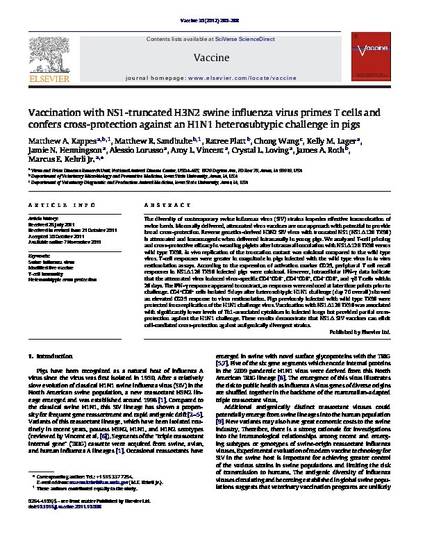
Article
Vaccination with NS1-Truncated H3N2 Swine Influenza Virus Primes T Cells and Confers Cross-Protection against an H1N1 Heterosubtypic Challenge in Pigs
Vaccine
Document Type
Article
Disciplines
Publication Version
Published Version
Publication Date
1-1-2012
DOI
10.1016/j.vaccine.2011.10.098
Abstract
The diversity of contemporary swine influenza virus (SIV) strains impedes effective immunization of swine herds. Mucosally delivered, attenuated virus vaccines are one approach with potential to provide broad cross-protection. Reverse genetics-derived H3N2 SIV virus with truncated NS1 (NS1Δ126 TX98) is attenuated and immunogenic when delivered intranasally in young pigs. We analyzed T-cell priming and cross-protective efficacy in weanling piglets after intranasal inoculation with NS1Δ126 TX98 versus wild type TX98. In vivo replication of the truncation mutant was minimal compared to the wild type virus. T-cell responses were greater in magnitude in pigs infected with the wild type virus in in vitro restimulation assays. According to the expression of activation marker CD25, peripheral T cell recall responses in NS1Δ126 TX98 infected pigs were minimal. However, intracellular IFN-γ data indicate that the attenuated virus induced virus-specific CD4+CD8–, CD4+CD8+, CD4–CD8+, and γδ T cells within 28 days. The IFN-γ response appeared to contract, as responses were reduced at later time points prior to challenge. CD4+CD8+ cells isolated 5 days after heterosubtypic H1N1 challenge (day 70 overall) showed an elevated CD25 response to virus restimulation. Pigs previously infected with wild type TX98 were protected from replication of the H1N1 challenge virus. Vaccination with NS1Δ126 TX98 was associated with significantly lower levels of Th1-associated cytokines in infected lungs but provided partial cross-protection against the H1N1 challenge. These results demonstrate that NS1Δ SIV vaccines can elicit cell-mediated cross-protection against antigenically divergent strains.
Rights
Works produced by employees of the U.S. Government as part of their official duties are not copyrighted within the U.S. The content of this document is not copyrighted.
Language
en
File Format
application/pdf
Citation Information
Matthew Allan Kappes, Matthew Robert Sandbulte, Ratree Platt, Chong Wang, et al.. "Vaccination with NS1-Truncated H3N2 Swine Influenza Virus Primes T Cells and Confers Cross-Protection against an H1N1 Heterosubtypic Challenge in Pigs" Vaccine Vol. 30 Iss. 2 (2012) p. 280 - 288 Available at: http://works.bepress.com/chong-wang/16/

This article is from Vaccine 30 (2012): 280, doi:10.1016/j.vaccine.2011.10.098.